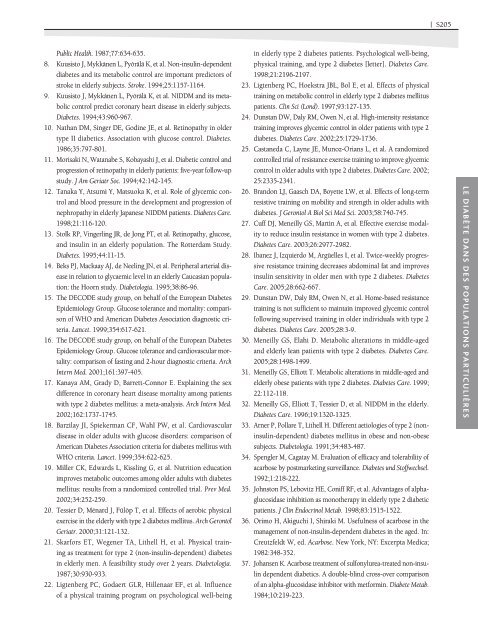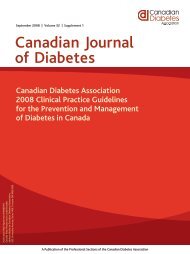Lignes directrices de pratique clinique 2008 de l - Canadian ...
Lignes directrices de pratique clinique 2008 de l - Canadian ...
Lignes directrices de pratique clinique 2008 de l - Canadian ...
You also want an ePaper? Increase the reach of your titles
YUMPU automatically turns print PDFs into web optimized ePapers that Google loves.
Public Health. 1987;77:634-635.<br />
8. Kuusisto J, Mykkänen L, Pyörälä K, et al. Non-insulin-<strong>de</strong>pen<strong>de</strong>nt<br />
diabetes and its metabolic control are important predictors of<br />
stroke in el<strong>de</strong>rly subjects. Stroke. 1994;25:1157-1164.<br />
9. Kuusisto J, Mykkänen L, Pyörälä K, et al. NIDDM and its metabolic<br />
control predict coronary heart disease in el<strong>de</strong>rly subjects.<br />
Diabetes. 1994;43:960-967.<br />
10. Nathan DM, Singer DE, Godine JE, et al. Retinopathy in ol<strong>de</strong>r<br />
type II diabetics. Association with glucose control. Diabetes.<br />
1986;35:797-801.<br />
11. Morisaki N, Watanabe S, Kobayashi J, et al. Diabetic control and<br />
progression of retinopathy in el<strong>de</strong>rly patients: five-year follow-up<br />
study. J Am Geriatr Soc. 1994;42:142-145.<br />
12. Tanaka Y, Atsumi Y, Matsuoka K, et al. Role of glycemic control<br />
and blood pressure in the <strong>de</strong>velopment and progression of<br />
nephropathy in el<strong>de</strong>rly Japanese NIDDM patients. Diabetes Care.<br />
1998;21:116-120.<br />
13. Stolk RP, Vingerling JR, <strong>de</strong> Jong PT, et al. Retinopathy, glucose,<br />
and insulin in an el<strong>de</strong>rly population. The Rotterdam Study.<br />
Diabetes. 1995;44:11-15.<br />
14. Beks PJ, Mackaay AJ, <strong>de</strong> Neeling JN, et al. Peripheral arterial disease<br />
in relation to glycaemic level in an el<strong>de</strong>rly Caucasian population:<br />
the Hoorn study. Diabetologia. 1995;38:86-96.<br />
15. The DECODE study group, on behalf of the European Diabetes<br />
Epi<strong>de</strong>miology Group. Glucose tolerance and mortality: comparison<br />
of WHO and American Diabetes Association diagnostic criteria.<br />
Lancet. 1999;354:617-621.<br />
16. The DECODE study group, on behalf of the European Diabetes<br />
Epi<strong>de</strong>miology Group. Glucose tolerance and cardiovascular mortality:<br />
comparison of fasting and 2-hour diagnostic criteria. Arch<br />
Intern Med. 2001;161:397-405.<br />
17. Kanaya AM, Grady D, Barrett-Connor E. Explaining the sex<br />
difference in coronary heart disease mortality among patients<br />
with type 2 diabetes mellitus: a meta-analysis. Arch Intern Med.<br />
2002;162:1737-1745.<br />
18. Barzilay JI, Spiekerman CF, Wahl PW, et al. Cardiovascular<br />
disease in ol<strong>de</strong>r adults with glucose disor<strong>de</strong>rs: comparison of<br />
American Diabetes Association criteria for diabetes mellitus with<br />
WHO criteria. Lancet. 1999;354:622-625.<br />
19. Miller CK, Edwards L, Kissling G, et al. Nutrition education<br />
improves metabolic outcomes among ol<strong>de</strong>r adults with diabetes<br />
mellitus: results from a randomized controlled trial. Prev Med.<br />
2002;34:252-259.<br />
20. Tessier D, Ménard J, Fülöp T, et al. Effects of aerobic physical<br />
exercise in the el<strong>de</strong>rly with type 2 diabetes mellitus. Arch Gerontol<br />
Geriatr. 2000;31:121-132.<br />
21. Skarfors ET, Wegener TA, Lithell H, et al. Physical training<br />
as treatment for type 2 (non-insulin-<strong>de</strong>pen<strong>de</strong>nt) diabetes<br />
in el<strong>de</strong>rly men. A feasibility study over 2 years. Diabetologia.<br />
1987;30:930-933.<br />
22. Ligtenberg PC, Godaert GLR, Hillenaar EF, et al. Influence<br />
of a physical training program on psychological well-being<br />
in el<strong>de</strong>rly type 2 diabetes patients. Psychological well-being,<br />
physical training, and type 2 diabetes [letter]. Diabetes Care.<br />
1998;21:2196-2197.<br />
23. Ligtenberg PC, Hoekstra JBL, Bol E, et al. Effects of physical<br />
training on metabolic control in el<strong>de</strong>rly type 2 diabetes mellitus<br />
patients. Clin Sci (Lond). 1997;93:127-135.<br />
24. Dunstan DW, Daly RM, Owen N, et al. High-intensity resistance<br />
training improves glycemic control in ol<strong>de</strong>r patients with type 2<br />
diabetes. Diabetes Care. 2002;25:1729-1736.<br />
25. Castaneda C, Layne JE, Munoz-Orians L, et al. A randomized<br />
controlled trial of resistance exercise training to improve glycemic<br />
control in ol<strong>de</strong>r adults with type 2 diabetes. Diabetes Care. 2002;<br />
25:2335-2341.<br />
26. Brandon LJ, Gaasch DA, Boyette LW, et al. Effects of long-term<br />
resistive training on mobility and strength in ol<strong>de</strong>r adults with<br />
diabetes. J Gerontol A Biol Sci Med Sci. 2003;58:740-745.<br />
27. Cuff DJ, Meneilly GS, Martin A, et al. Effective exercise modality<br />
to reduce insulin resistance in women with type 2 diabetes.<br />
Diabetes Care. 2003;26:2977-2982.<br />
28. Ibanez J, Izquierdo M, Argüelles I, et al. Twice-weekly progressive<br />
resistance training <strong>de</strong>creases abdominal fat and improves<br />
insulin sensitivity in ol<strong>de</strong>r men with type 2 diabetes. Diabetes<br />
Care. 2005;28:662-667.<br />
29. Dunstan DW, Daly RM, Owen N, et al. Home-based resistance<br />
training is not sufficient to maintain improved glycemic control<br />
following supervised training in ol<strong>de</strong>r individuals with type 2<br />
diabetes. Diabetes Care. 2005;28:3-9.<br />
30. Meneilly GS, Elahi D. Metabolic alterations in middle-aged<br />
and el<strong>de</strong>rly lean patients with type 2 diabetes. Diabetes Care.<br />
2005;28:1498-1499.<br />
31. Meneilly GS, Elliott T. Metabolic alterations in middle-aged and<br />
el<strong>de</strong>rly obese patients with type 2 diabetes. Diabetes Care. 1999;<br />
22:112-118.<br />
32. Meneilly GS, Elliott T, Tessier D, et al. NIDDM in the el<strong>de</strong>rly.<br />
Diabetes Care. 1996;19:1320-1325.<br />
33. Arner P, Pollare T, Lithell H. Different aetiologies of type 2 (noninsulin-<strong>de</strong>pen<strong>de</strong>nt)<br />
diabetes mellitus in obese and non-obese<br />
subjects. Diabetologia. 1991;34:483-487.<br />
34. Spengler M, Cagatay M. Evaluation of efficacy and tolerability of<br />
acarbose by postmarketing surveillance. Diabetes und Stoffwechsel.<br />
1992;1:218-222.<br />
35. Johnston PS, Lebovitz HE, Coniff RF, et al. Advantages of alphaglucosidase<br />
inhibition as monotherapy in el<strong>de</strong>rly type 2 diabetic<br />
patients. J Clin Endocrinol Metab. 1998;83:1515-1522.<br />
36. Orimo H, Akiguchi I, Shiraki M. Usefulness of acarbose in the<br />
management of non-insulin-<strong>de</strong>pen<strong>de</strong>nt diabetes in the aged. In:<br />
Creutzfeldt W, ed. Acarbose. New York, NY: Excerpta Medica;<br />
1982:348-352.<br />
37. Johansen K. Acarbose treatment of sulfonylurea-treated non-insulin<br />
<strong>de</strong>pen<strong>de</strong>nt diabetics. A double-blind cross-over comparison<br />
of an alpha-glucosidase inhibitor with metformin. Diabete Metab.<br />
1984;10:219-223.<br />
| S205<br />
Le diaBÈte dans <strong>de</strong>s pOpuLatiOns particuLiÈres











